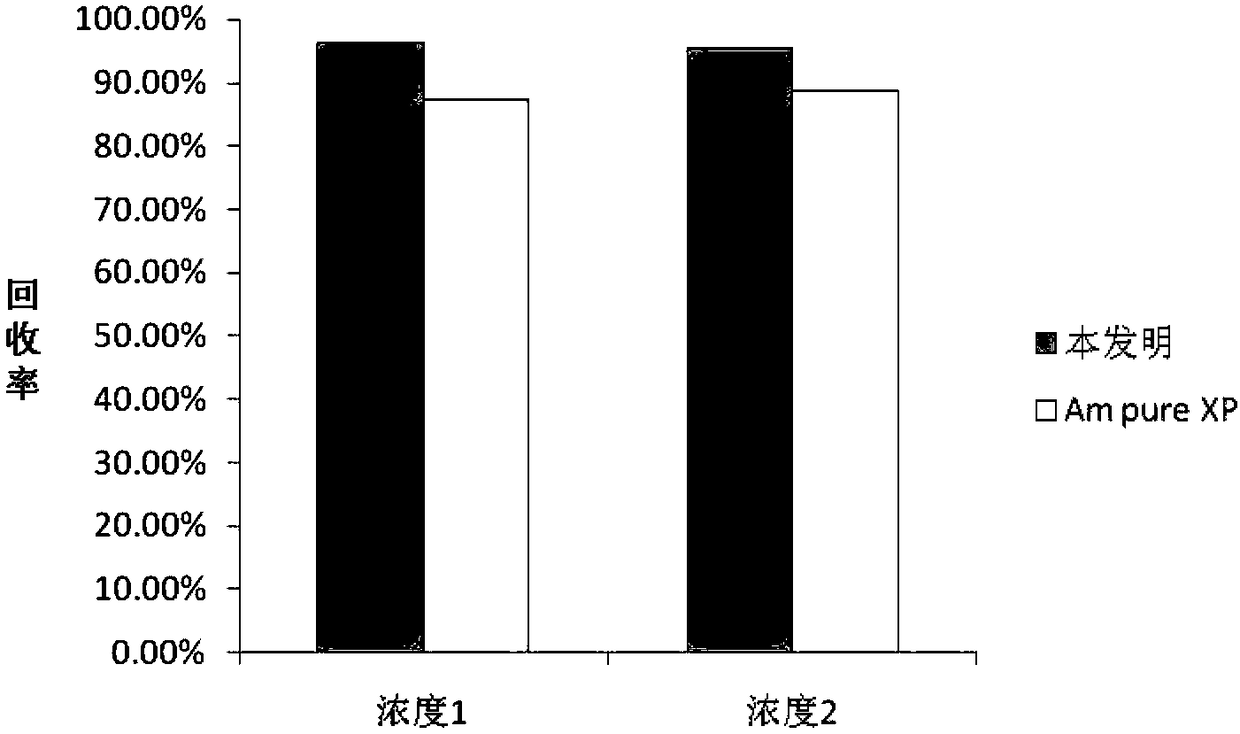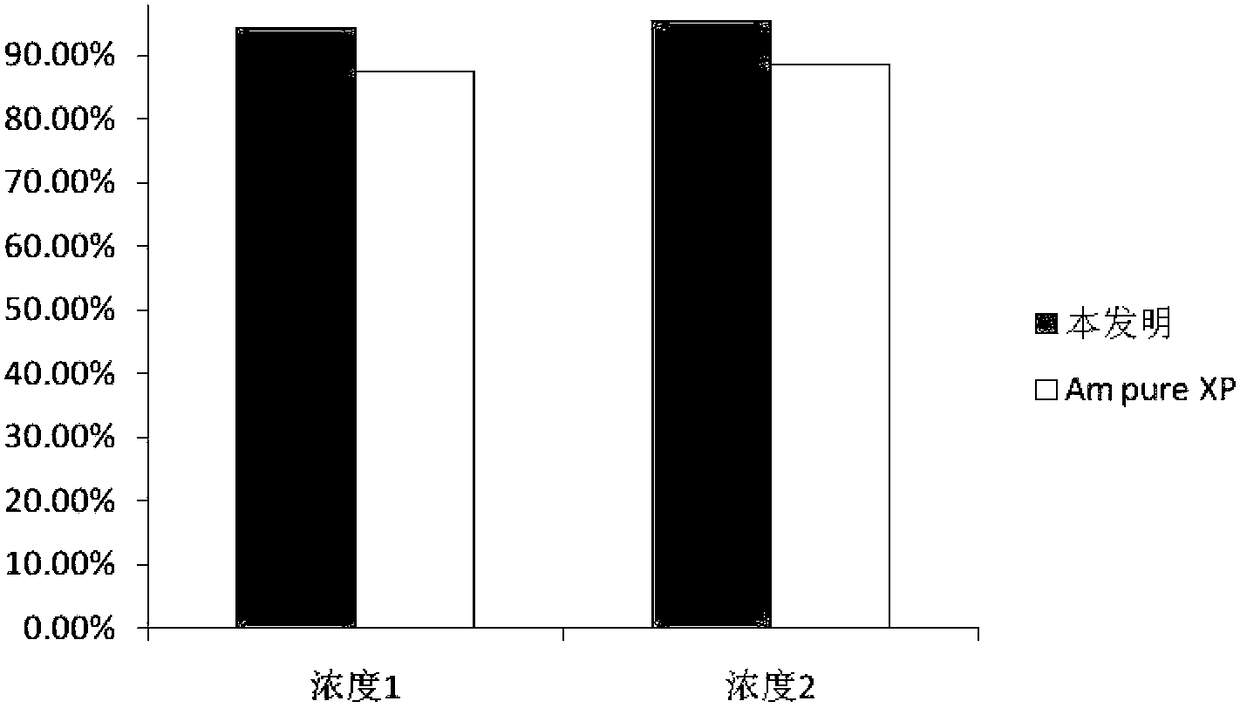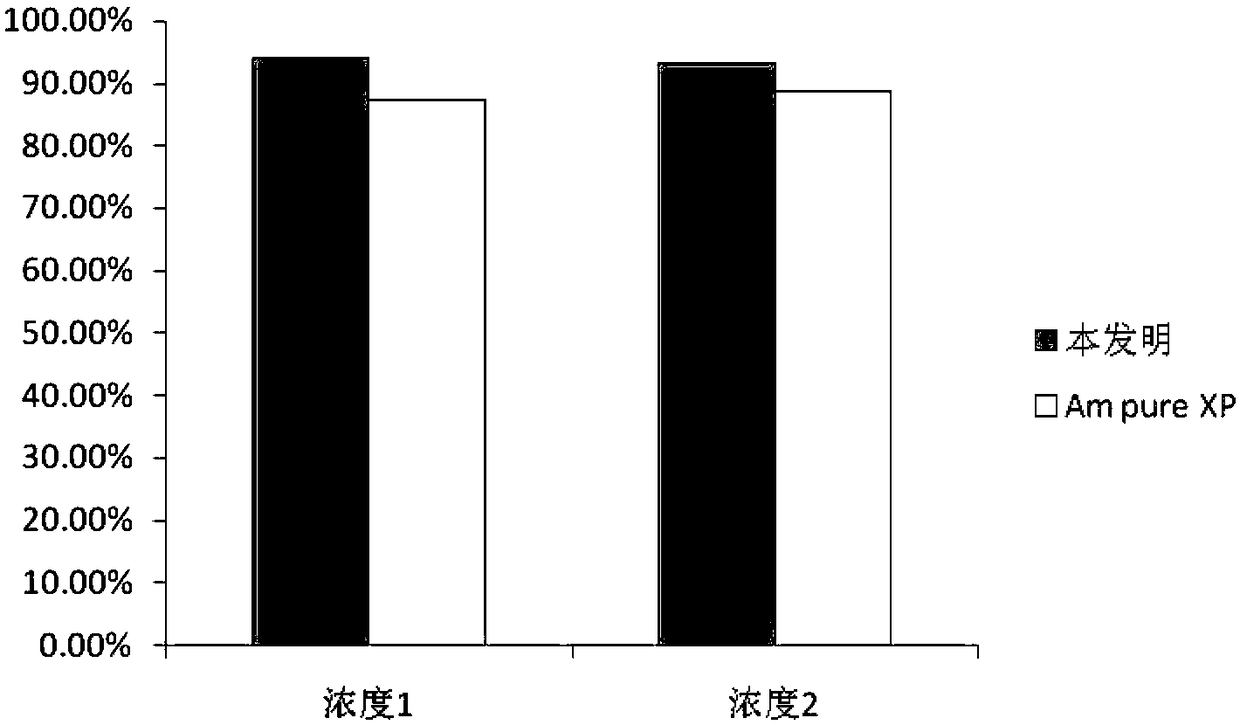Nucleic acid purification reagent based on magnetic bead method
A magnetic bead method and nucleic acid technology, applied in the field of molecular biology, can solve the problems of low recovery rate, difficulty in rare sampling, low initial amount of samples to be processed, etc., and achieve good recovery efficiency and low recovery loss
- Summary
- Abstract
- Description
- Claims
- Application Information
AI Technical Summary
Problems solved by technology
Method used
Image
Examples
Embodiment 1
[0018] Get the PCR purification products whose concentrations are respectively 16.6ng / μL (concentration one) and 22.8ng / μL (concentration two), contain the fragments that are 127bp and 306bp in size respectively, utilize nucleic acid purification reagent and kit of the present invention, measure two respectively The recoveries of samples with different concentrations.
[0019] 1) Put 20 μL of PCR purified product into a centrifuge tube, add 38 μL of nucleic acid purification reagent to the centrifuge tube, mix well, let stand at room temperature for 5 minutes, then place the centrifuge tube on a magnetic stand until the supernatant is clear, and discard the supernatant.
[0020] Wherein, the nucleic acid purification reagent is composed of the following raw materials in mass fractions: 5% carboxyl-modified magnetic beads, 19% sodium chloride, 18% polyethylene glycol, 0.04% sodium N-lauroyl sarcosinate, 0.16% Tris-HCl, 2% EDTA and 0.5% Tween 20, the balance is water.
[0021] ...
Embodiment 2
[0026] Get the PCR purification products whose concentrations are respectively 16.6ng / μL (concentration one) and 22.8ng / μL (concentration two), contain the fragments that are 127bp and 306bp in size respectively, utilize nucleic acid purification reagent and kit of the present invention, measure two respectively The recoveries of samples with different concentrations.
[0027] 1) Put 20 μL of PCR purified product into a centrifuge tube, add 38 μL of nucleic acid purification reagent to the centrifuge tube, mix well, let stand at room temperature for 5 minutes, then place the centrifuge tube on a magnetic stand until the supernatant is clear, and discard the supernatant.
[0028] Wherein, the components added in the nucleic acid purification reagent are: 3% carboxy-modified magnetic beads, 11.78% sodium chloride, 20% polyethylene glycol, 0.05% sodium N-lauroyl sarcosinate, 0.79% Tris-HCl , 0.5% EDTA, 1% Tween 20, and the rest is water.
[0029] 2) Add 200 μL of washing buffer ...
Embodiment 3
[0034] Get the PCR purification products whose concentrations are respectively 16.6ng / μL (concentration one) and 22.8ng / μL (concentration two), contain the fragments that are 127bp and 306bp in size respectively, utilize nucleic acid purification reagent and kit of the present invention, measure two respectively The recoveries of samples with different concentrations.
[0035] 1) Put 20 μL of PCR purified product into a centrifuge tube, add 38 μL of nucleic acid purification reagent to the centrifuge tube, mix well, let stand at room temperature for 5 minutes, then place the centrifuge tube on a magnetic stand until the supernatant is clear, and discard the supernatant.
[0036] Wherein, the components added in the nucleic acid purification reagent are: 1% carboxy-modified magnetic beads, 23.56% sodium chloride, 10% polyethylene glycol, 0.01% sodium N-lauroyl sarcosinate, 0.5% Tris-HCl , 1.5% EDTA, 2% Tween 20, and the remaining ingredients are water.
[0037]2) Add 200 μL of...
PUM
 Login to View More
Login to View More Abstract
Description
Claims
Application Information
 Login to View More
Login to View More - R&D
- Intellectual Property
- Life Sciences
- Materials
- Tech Scout
- Unparalleled Data Quality
- Higher Quality Content
- 60% Fewer Hallucinations
Browse by: Latest US Patents, China's latest patents, Technical Efficacy Thesaurus, Application Domain, Technology Topic, Popular Technical Reports.
© 2025 PatSnap. All rights reserved.Legal|Privacy policy|Modern Slavery Act Transparency Statement|Sitemap|About US| Contact US: help@patsnap.com



